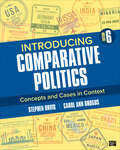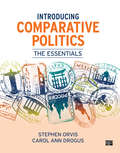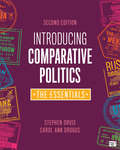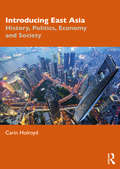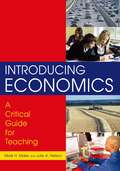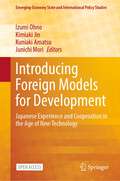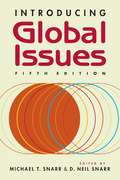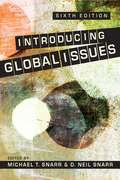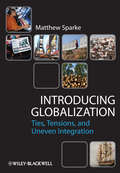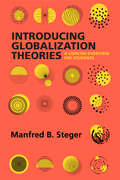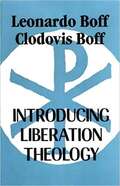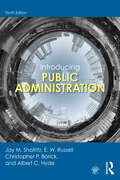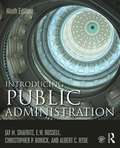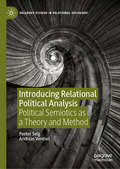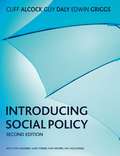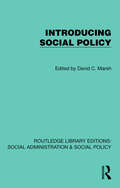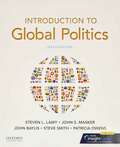- Table View
- List View
Introducing Comparative Politics: Concepts and Cases in Context
by Carol Ann Drogus Stephen Walter OrvisOrganized thematically around important questions in comparative politics, the Sixth Edition of Introducing Comparative Politics integrates a set of extended case studies that vividly illustrate issues in cross-national context for 11 countries. The cases are placed within the chapters where they make the most sense —not separated from the theory or in a separate volume—helping students make connections between theory and practice earlier in the semester and giving them a more holistic view of comparative politics. This title is accompanied by a complete teaching and learning package. Contact your Sage representative to request a demo. Learning Platform / Courseware Sage Vantage is an intuitive learning platform that integrates quality Sage textbook content with assignable multimedia activities and auto-graded assessments to drive student engagement and ensure accountability. Unparalleled in its ease of use and built for dynamic teaching and learning, Vantage offers customizable LMS integration and best-in-class support. It′s a learning platform you, and your students, will actually love. Learn more. Assignable Video with Assessment Assignable video (available in Sage Vantage) is tied to learning objectives and curated exclusively for this text to bring concepts to life. LMS Cartridge: Import this title’s instructor resources into your school’s learning management system (LMS) and save time. Don′t use an LMS? You can still access all of the same online resources for this title via the password-protected Instructor Resource Site. Learn more.
Introducing Comparative Politics: Concepts and Cases in Context
by Carol Ann Drogus Stephen Walter OrvisOrganized thematically around important questions in comparative politics, the Sixth Edition of Introducing Comparative Politics integrates a set of extended case studies that vividly illustrate issues in cross-national context for 11 countries. The cases are placed within the chapters where they make the most sense —not separated from the theory or in a separate volume—helping students make connections between theory and practice earlier in the semester and giving them a more holistic view of comparative politics. This title is accompanied by a complete teaching and learning package. Contact your Sage representative to request a demo. Learning Platform / Courseware Sage Vantage is an intuitive learning platform that integrates quality Sage textbook content with assignable multimedia activities and auto-graded assessments to drive student engagement and ensure accountability. Unparalleled in its ease of use and built for dynamic teaching and learning, Vantage offers customizable LMS integration and best-in-class support. It′s a learning platform you, and your students, will actually love. Learn more. Assignable Video with Assessment Assignable video (available in Sage Vantage) is tied to learning objectives and curated exclusively for this text to bring concepts to life. LMS Cartridge: Import this title’s instructor resources into your school’s learning management system (LMS) and save time. Don′t use an LMS? You can still access all of the same online resources for this title via the password-protected Instructor Resource Site. Learn more.
Introducing Comparative Politics: The Essentials
by Carol Ann Drogus Stephen OrvisFor Introducing Comparative Politics: The Essentials, the driving force is the pluralist, objective stance on introducing students to core concepts in Comparative Politics. Authors Stephen Orvis and Carol Ann Drogus introduce key comparative questions while providing equal strengths and weaknesses of commonly debated theories, structures, and beliefs that push students beyond memorization of country profiles and ever-changing statistics and generate in-class debate over key concepts used in the science of comparative politics. While detailed case studies can go in-depth on specific countries and political systems, Introducing Comparative Politics: The Essentials, distills its country material into paragraph-long examples woven seamlessly into the narrative of the text, increasing diverse global awareness, current-event literacy, and critical-thinking skills.
Introducing Comparative Politics: The Essentials
by Carol Ann Drogus Stephen OrvisFor Introducing Comparative Politics: The Essentials, the driving force is the pluralist, objective stance on introducing students to core concepts in Comparative Politics. Authors Stephen Orvis and Carol Ann Drogus introduce key comparative questions while providing equal strengths and weaknesses of commonly debated theories, structures, and beliefs that push students beyond memorization of country profiles and ever-changing statistics and generate in-class debate over key concepts used in the science of comparative politics. While detailed case studies can go in-depth on specific countries and political systems, Introducing Comparative Politics: The Essentials, distills its country material into paragraph-long examples woven seamlessly into the narrative of the text, increasing diverse global awareness, current-event literacy, and critical-thinking skills.
Introducing Comparative Politics: The Essentials
by Carol Ann Drogus Stephen Walter OrvisIntroducing Comparative Politics: The Essentials is focused on core concepts and the big picture questions in comparative politics—Who rules? What explains political behavior? Where and why? Stephen Orvis and Carol Ann Drogus demonstrate the strengths and weaknesses of commonly debated theories, structures, and beliefs and push students to apply their understanding. While detailed case studies can go in-depth on specific countries and political systems, this book distills its country material into the narrative, increasing global awareness, current-event literacy, and critical-thinking skills. Adapted from the authors’ Introducing Comparative Politics, Fifth Edition, The Essentials version offers the same framework for understanding comparative politics in a briefer format, allowing you to teach the course the way you want to teach it.
Introducing Comparative Politics: The Essentials
by Carol Ann Drogus Stephen Walter OrvisIntroducing Comparative Politics: The Essentials is focused on core concepts and the big picture questions in comparative politics—Who rules? What explains political behavior? Where and why? Stephen Orvis and Carol Ann Drogus demonstrate the strengths and weaknesses of commonly debated theories, structures, and beliefs and push students to apply their understanding. While detailed case studies can go in-depth on specific countries and political systems, this book distills its country material into the narrative, increasing global awareness, current-event literacy, and critical-thinking skills. Adapted from the authors’ Introducing Comparative Politics, Fifth Edition, The Essentials version offers the same framework for understanding comparative politics in a briefer format, allowing you to teach the course the way you want to teach it.
Introducing East Asia: History, Politics, Economy and Society
by Carin HolroydIntroducing East Asia is an ideal textbook for those new to the study of one of the most exciting and important regions in the world. East Asia is a complex and culturally rich region, with the Chinese, Korean and Japanese civilizations among the oldest in the world. Over the past 50 years, Japan, South Korea, Taiwan and China have become economic powerhouses and leaders in the commercialization of science and technology. The countries are economically and culturally intertwined while at the same time burdened by a history of war and conflict. This textbook focuses on the historical and cultural roots of the contemporary political and economic ascendency of East Asia and explores the degree to which East Asian cultures, values and history set up the region for 21st century global leadership. Features in this textbook include: • Chapters on each of the countries and special economic zones that make up the region. • Rich illustrations and timelines to guide the student visually. • Focused textboxes on key figures and events, useful as research assignment and revision materials. Providing undergraduate students with a solid introduction to East Asia, this textbook will be an essential reading for students of East Asian studies, global studies and international studies.
Introducing Economics: A Critical Guide for Teaching
by Julie Nelson Mark H. MaierMake economics resonate to high school students. This practical handbook will help economics and social studies teachers foster critical thinking by introducing students to the real-life dimensions of the major controversies in contemporary economics. Filled with useful teaching tips and user-friendly information on finding engaging materials and activities for the classroom, the book also includes detailed coverage of the Voluntary National Content Standards for economics. "Introducing Economics" is a one-stop resource for high school teachers who want to make economics relevant to their students' lives. It includes more than 50 sections with lists of suggested "Activities and Resources," many with Internet links. It features boxed "Hints for Clear Teaching" tips for presenting particularly difficult topics. It provides an annotated resource guide to more than 30 organizations involved in economics education, with associated Internet links. It follows the flow of topics in a typical economics course. It addresses real-life topics that are ignored or glossed-over in traditional textbooks - economics and the environment, the distribution of income and wealth, discrimination, labor unions, globalization, the power of corporations, and more. It offers critical guidance for meeting all 20 Voluntary National Content Standards in economics, and also provides an overview of the political and intellectual history and contemporary state of economics education.
Introducing Foreign Models for Development: Japanese Experience and Cooperation in the Age of New Technology (Emerging-Economy State and International Policy Studies)
by Kimiaki Jin Izumi Ohno Kuniaki Amatsu Junichi MoriThis open access book studies how foreign models of economic development can be effectively learned by and applied to today’s latecomer countries. Policy capacity and societal learning are increasingly stressed as pre-conditions for successful catch-up. However, how such learning should be initiated by individual societies with different features needs to be explained. The book answers this pragmatic question from the perspective of Japan’s past experience and its extensive development cooperation in Asia, Africa, and Latin America. Since the late nineteenth century, Japan has developed a unique philosophy and method for adopting advanced technologies and systems from the West; the same philosophy and method govern its current cooperation with the developing world.The key concepts are local learning and translative adaptation. Local learning says that development requires the learner to adopt a proactive mindset and the goal of graduating from receiving aid. Meanwhile, translative adaptation requires foreign models be modified to fit local realities given the different structures of the home and foreign society. The development process must be wholly owned by the domestic society in rejection of copy-and-paste acceptance. These ideas not only informed Japan but are key to successful development for all. The book also asks how this learning method should—or should not—be revised in the age of SDGs and digitalization. Following the overview section that lays out the general principles, the book offers many real cases from Japan and other countries. The concrete actions outlined in these cases, with close attention to individual growth “ingredients” as opposed to general theories, are crucial to successful policy making. The book contains materials that are highly useful for national leaders and practitioners within developing countries as well as students of development studies.
Introducing Global Issues (5th Edition)
by Michael T. Snarr D. Neil SnarrThe conflict in Libya, concerns over Iran's nuclear program, the global recession, debates about climate change, the importance of human security, the growing impact of technology ... all are reflected in this new, fully revised and updated edition of Introducing Global Issues. The authors cover the full range of global issues, from conflict and security, to the economy and economic development, to the environment. The material has been successfully designed for readers with little or no prior knowledge of the topics covered. Each chapter provides an analytical overview of the issues addressed, identifies the central actors and perspectives, and outlines past progress and future prospects. Discussion questions are posed to enhance students¿ appreciation of the complexities involved, and suggestions for further reading additionally enrich the text.
Introducing Global Issues (Sixth Edition)
by Michael T. Snarr D. Neil SnarrHow is new technology - cyberwarfare, drones, and more - affecting global security? Are the 2015 Sustainable Development Goals having an impact What progress are governments making in dealing with climate change? Is there a viable solution to the Syrian refugee crisis? How do we reconcile the concepts of universal human rights and national sovereignty?.
Introducing Globalization
by Matthew SparkeDesigned specifically for introductory globalization courses, Introducing Globalization helps students to develop informed opinions about globalization, inviting them to become participants rather than just passive learners.Identifies and explores the major economic, political and social ties that comprise contemporary global interdependencyExamines a broad sweep of topics, from the rise of transnational corporations and global commodity chains, to global health challenges and policies, to issues of worker solidarity and global labor markets, through to emerging forms of global mobility by both business elites and their criticsWritten by an award-winning teacher, and enhanced throughout by numerous empirical examples, maps, tables, an extended bibliography, glossary of key terms, and suggestions for further reading and student researchSupported by additional web resources - available upon publication at www.wiley.com/go/sparke - including hot links to news reports, examples of globalization and other illustrative sites, and archived examples of student projectsEngage with fellow readers of Introducing Globalization on the book's Facebook page at www.facebook.com/IntroducingGlobalization, or learn more about this topic by enrolling in the free Coursera course Globalization and You at www.coursera.org/course/globalization
Introducing Globalization Theories: A Concise Overview for Students
by Prof. Manfred B. StegerSince the explosion of the buzzword "globalization" in academic and public discourse more than thirty years ago, theoretical explorations of worldwide interconnectivities and mobilities have proliferated across major academic disciplines. Introducing Globalization Theories is a short yet comprehensive primer to major globalization theories from the 1990s to the present. This accessible volume explains how globalization frameworks have been assembled by influential thinkers who employ different modes of inquiry. Short summaries, illustrations, and a supplemental guide to further reading equip students with tools to assess the strengths and weaknesses of each theory. Intersecting with relevant contemporary themes such as inequality and ecology, the book also highlights and features postcolonial and Indigenous globalization theories that challenge Western-centric views and point to a more equitable world.
Introducing Globalization: Analysis and Readings
by Mansbach, Richard W. and Rhodes, EdwardLooking for a reader on globalization that is just as exciting as the topic itself? That comprehensively covers the issues and perspectives you and your students want to talk about? That frames the readings with clear, substantial, and original analysis by a pair of preeminent scholars? In their new edited volume, Mansbach and Rhodes offer the guidance students need to work through the varied and lively selections of scholarly and journalistic, theoretical and practical pieces, from both U.S. and international writers.
Introducing International Relations
by Paul SharpThis exciting new textbook provides an accessible and lively introduction to international relations for students encountering the subject for the first time. Presenting complex ideas, concepts and arguments in a straightforward and conversational way, the textbook explains international relations from a diplomatic perspective, emphasizing co-existence in the absence of agreement, and developing students’ ability to make sense of the current conditions of international uncertainty. Introducing students to the major theories and issues in international relations, each chapter: is written to a common structure, dividing each topic into sections with learning objectives within each section to provide points of focus for students and instructors includes extensive text box examples and short case studies for reflection and discussion provides key terms, key takeaways and simple exercises which require short responses offers a suggested list of further readings for those who wish to explore a topic further. The first introductory textbook to take a diplomatic approach, this text is essential reading for all those looking to take their first steps into the study of international relations in an era of uncertainty.
Introducing Liberation Theology
by Leonardo Boff Paul Burns Clodovis BoffThis work deals with the basic questions that are tackled by liberation theology - oppression, violence, domination and marginalization. It then goes on to show how the Christian faith can be used as an agent in promoting social and individual liberation, and how faith and politics relate.
Introducing Public Administration
by Jay M. Shafritz Christopher P. Borick Albert C. Hyde E. W. RussellNow in an extensively revised tenth edition, Introducing Public Administration provides students with the conceptual foundation they need, while introducing them to important trends in the discipline. This classic textbook—blending historical accounts with contemporary events—examines the most important issues in the field of public administration through the use of examples from various disciplines and modern culture. Its approach of using extensive case studies at the end of each chapter encourages students to think critically about the nature, purpose, and public value of public administration today.Refreshed and revised throughout, the tenth edition contains a number of critical updates for the field: All-new case studies at the end of each chapter to address various challenges, including social justice, climate change action, smart cities, transforming governmental institutions, and economic responses to the global pandemic. The case studies—many with legal dimensions as well—cover emerging issues and are well suited for further research by students. Two chapters by contributing authors on 1) Social equity and justice, covering contemporary challenges in the US, from police reform to voting rights and homelessness, and 2) Public budgeting, contrasting government fiscal efforts between two recessions, illuminating successes and failures with a case study on the federal government shutdown in 2019 over border wall funding. Keynotes at the start of each chapter to help introduce students to historical figures, contemporary dilemmas, and examples of public service in action, including subjects such as diversity and inclusion, marijuana legalization, organizational effects of remote work, and examining scenarios for the future. A completely rewritten concluding chapter on leadership, followership, and leading teams with a discussion of destructive leadership types and a flipped case study on defining what leadership effectiveness is. Complete with a fully updated companion website containing instructor slides for each chapter, a chapter-by-chapter instructor’s manual and sample syllabus, student learning objectives, and self-test questions, Introducing Public Administration is the ideal introduction to the discipline for first year masters students, as well as for the growing number of undergraduate public administration courses and programs.
Introducing Public Administration (7th edition)
by Jay M. Shafritz Christopher P. Borick E. W. RussellIntroducing Public Administration provides students with a solid, conceptual foundation in public administration, and contains the latest information on important trends in the discipline.
Introducing Public Administration (9th Edition)
by Jay M. Shafritz E. W. Russell Albert C. Hyde Christopher BorickThis is the now the 9th edition of a text first published in 1997. There's only one audience for a book of this nature--practitioners, students and teachers of public administration. In the original preface to this book we explained that we sought to create a text that would bridge two worlds, a text that would be informal enough to be accessible to undergraduates yet comprehensive enough for graduate students.
Introducing Public Administration (Ninth Edition)
by Jay M. Shafritz Christopher P. Borick E. W. Russell Albert C. Hyde<p>Now in an extensively revised 9th edition, Introducing Public Administration provides students with the conceptual foundation they need, while introducing them to important trends in the discipline. Known for its lively and witty writing style, this beloved textbook examines the most important issues in the field of public administration through the use of examples from various disciplines and modern culture. This unique approach captivates students and encourages them to think critically about the nature of public administration today. Refreshed and revised throughout, the 9th edition contains a number of important updates: <p> <li>An examination of the effect of the Barack Obama administration on the discipline, especially economic and financial management and budgetary policy, allowing students to apply the theories and concepts in the text to recent US government practice. <li>An exploration of the 2008 economic meltdown and its consequences for the regulation of financial markets, cut-back management, and social equity, providing students with a critical look at the recent changes in the global economy. <li>All-new images, international examples, keynotes, and case studies have been incorporated to reflect the diversity of public servants throughout history. Case studies correspond to those in optional companion book Cases in Public Policy and Administration to offer clear discussion points and seamless learning with the two books side by side. <li>New sections on careers in public service, whistleblowing and public employee dissent, networks and collaboration across organizations, social innovation, managerialism and productivity improvement, Big Data and cloud computing, collaboration and civic engagement, and evidence-based policy and management.</li> <p> <p>Complete with a companion website containing instructor slides for each chapter, a chapter-by-chapter instructor's manual and sample syllabus, student learning objectives and self-test questions, Introducing Public Administration is the ideal introduction to the discipline for first year masters students, as well as for the growing number of undergraduate public administration courses and programs.</p>
Introducing Relational Political Analysis: Political Semiotics as a Theory and Method (Palgrave Studies in Relational Sociology)
by Andreas Ventsel Peeter SelgThis book introduces relational thinking to political analysis. Instead of merely providing an overview of possible trajectories for articulating a relational political analysis, Peeter Selg and Andreas Ventsel put forth a concrete relational theory of the political, which has implications for research methodology, culminating in a concrete method they call political form analysis. In addition, they sketch out several applications of this theory, methodology and method. They call their approach “political semiotics” and argue that it is a fruitful way of conducting research on power, governance and democracy – the core dimensions of the political – in a manner that is envisioned in numerous discussions of the “relational turn” in the social sciences. It is the first monograph that attempts to outline an approach to the political that would be relational throughout, from its meta theoretical and theoretical premises through to its methodological implications, methods and empirical applications.
Introducing Social Policy
by Guy Daly Cliff Alcock Edwin GriggsThe completely revised second edition of this highly respected textbook provides a comprehensive yet digestible and accessible introduction to the theoretical foundations, development and crucial areas of contemporary concern in social policy and welfare. Fully up to date, it provides a concise but thorough overview of the context for the provision of social welfare in contemporary Britain and beyond. Providing an integrated framework to highlight the relationships between theory, policy and practice, Introducing Social Policy examines social policy from a multi-disciplinary perspective. It therefore encourages a broad understanding of the importance of the subject within social policy itself, as well in social work, healthcare, education and beyond.
Introducing Social Policy (Routledge Library Editions: Social Administration & Social Policy)
by David C. MarshOriginally published in 1979, this book concentrates on the major developments in social policy in the second half of the 20th century. The first part considers these in relation to the economic and social environment, comprising essays on social policy in relation to industry, urban planning, and housing need. Further chapters consider social policies designed to meet individual needs such as education, health, and the maintenance of income. The final section deals with personal social services, and the relation of social policy to crime. For its breadth and scope of coverage the book will be of interest to all students of the history of social policy and social work.
Introducing Urban Design: Interventions and Responses (Introduction To Planning Series)
by Clara Greed Marion RobertsIntroducing Urban Design: Interventions and Responses is a new departure in the town planning series under the editorship of Clara Greed. The dynamic new subject and profession of urban design straddles the fields of town planning, architecture, landscape architecture and transport planning. This book recognises that a key feature of modern urban design practice is the ability to integrate a concern with the visual and aesthetic aspects of urban form, with a strong social awareness of the need of user groups, plus a sensitivity to wider environmental and sustainability issues. In this it continues the themes already introduced in earlier volumes, such as the changing nature of the profession, social problems and the means of implementing policy. Written by a team of eminent urban designers, architects and planners under the joint editorship of Clara Greed and Marion Roberts, the book introduces the reader to the subject through a discussion of current issues, approaches and user responses.Introducing Urban Design: Interventions and Responses is an ideal resource for undergraduate courses in town planning, architecture, landscape architecture, estate management and housing studies. It is also suitable as an introductory text for first year diploma and masters programmes in urban design and suitable for RTPI, RICS, CIOH, CIOB, ASI, ISVA and RIBA courses and will be of interest to professional practioners in the urban design field.
Introduction To Global Politics
by Steve Smith Patricia Owens John Baylis Steven L. Lamy John S. MaskerIntroduction to Global Politics, Sixth Edition, provides a current, engaging, and non-U.S. perspective on global politics. It shows students how to analyze global political events using theoretical approaches--both mainstream and alternative--and emphasizes non-state actors more than any other global politics text. The book offers a robust ancillary resource program, including FREE interactive media activities designed to reinforce key concepts by simulating real-world situations, making Introduction to Global Politics, Sixth Edition, the perfect text to engage your students.
